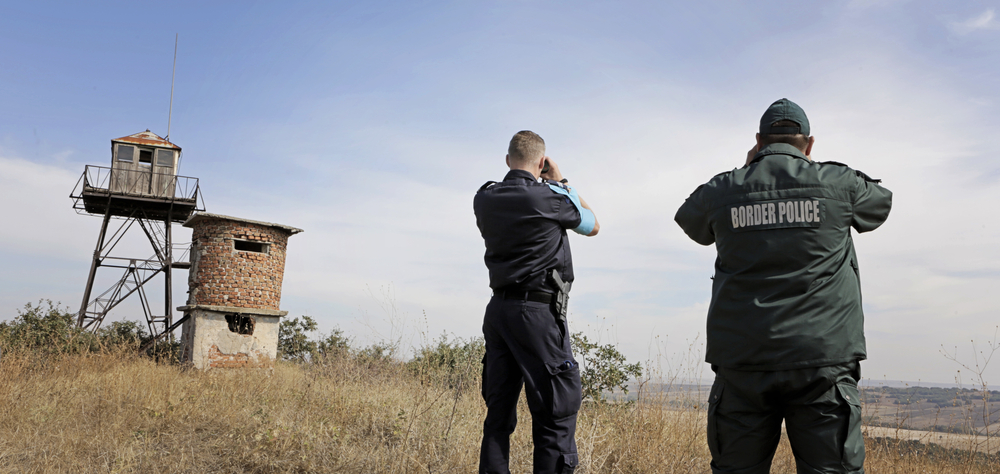by John Feffer
Nation-states: what a quaint notion.
As a means of organizing territory, they seem to be a brief transition period between large empires and an even larger, borderless world. Sure, nation-states might live on in the form of anthems and flags and independence days, but the idea of fixed borders just doesn’t make sense in a world of cell phones, the Internet, and global assembly lines. Borders just seem like a twentieth-century contrivance that slows everything down, like those paper forms you still have to fill out at the doctor’s office.
But just when you think you’ve progressed to the next level, along comes a reminder that the past is nipping at your heels, eager to bring you down.
This Sunday, Donald Trump temporarily closed the border crossing at San Ysidro in San Diego, across from Tijuana, Mexico. In response to a surge in migrants and asylum-seekers from Central America, the president has threatened to close the entire border permanently and even shut down the U.S. government if Congress doesn’t fund his border wall.
Also this Sunday, the European Union approved British Prime Minister Theresa May’s Brexit proposal. If the British parliament gives its okay, Britain will begin its formal withdrawal from the transnational pact at the end of March. Parliamentary approval, however, is far from certain, which leaves the border between the EU and its second most economically powerful member still very much up in the air.
Finally, in the Azov Sea this Sunday, Russian border patrol boats opened fire on three Ukrainian vessels and then took them into custody. Russia is currently holding 24 Ukrainian sailors. Both Russia and Ukraine border the Sea of Azov, as does the disputed territory of Crimea. It’s only the latest in a long series of clashes over the border between the two most populous successor states of the Soviet Union.
The border disputes this Sunday were by no means the only ones. Tensions continue over who controls what islands and reefs in the South China Sea. Israel and Palestine continue to clash around the Gaza border and over the West Bank. Syria remains an internally divided country, as is Libya and, frankly, Iraq as well.
Borders are back in fashion. Whether they’re trying to keep out immigrants, confront neighbors, or just reassert sovereignty in an increasingly intrusive world, the latest batch of nationalist and authoritarian leaders are challenging the notion that history is heading in an ever more frictionless direction.
Actually, these leaders are all about friction, especially at the borders, because that’s precisely where worldviews rub up against each other and create dangerous sparks.
The Break
The decision by a narrow majority of Britons, in a 2016 referendum, to leave the EU was impulsive, uninformed, and splenetic. It was, ultimately, a crime of passion. And now, unless someone issues a last-minute reprieve, the authorities are going to execute the judgment.
I can’t resist another metaphor. There is no good Brexit, just as there is no good broken kneecap. They are both ruptures that require careful surgery and a long period of rehabilitation. In this case, there’s not just one fracture. Other border issues have included Gibraltar (resolved at the last minute), Northern Ireland (still unclear), and Scotland (it might vote for independence in order to negotiate its own EU membership).
The “soft” Brexit deal to which May and the EU have agreed would keep the UK in the trade area, for a transition period, but also force it to comply with many of the EU regulations that prompted the “leave” campaign to begin with. That’s why a number of May’s cabinet ministers, including Foreign Minister Boris Johnson, resigned in mid-November. They wanted a “hard” Brexit that represents a clean break with the EU regulatory system – a deal that the EU was not likely to approve.
If the British parliament rejects May’s proposal, however, the prime minister might be forced to negotiate a divorce without any deal at all, the hardest of hard Brexits. At the moment, the parliament seems to be gearing up to do just that, though May will use the threat of impending chaos to force the wary to line up behind her.
There are other possibilities, such as an even softer “Norway-plus” arrangement. Also, the European Court of Justice is now considering whether an interpretation of Article 50 of the Lisbon Treaty – which covers withdrawal from the EU – could permit Britain to revoke its Brexit declaration unilaterally. If that’s the case, then, the British could go ahead with a second referendum to see if the people, now apprised of the consequences of their actions, are willing to change their minds. It’s a rewind button that those who commit crimes of passion and break their kneecaps are not given. Back in March, the people building a new anti-Brexit campaign, with the help of donors like George Soros, gave the prospects of a second referendum at 50/50. With the May government increasingly rickety, the EU standing firm, and virtually everyone predicting economic decline under any Brexit scenario, those odds have gone up.
Still, as Andrew Rawnsley points out in The Guardian, preaching to the Remainers may not be enough to secure a win the second time around.
It is one thing to hold Boris Johnson and his gang to account for the mendacities they peddled in 2016. It is another thing to say that the millions of voters who bought into the bogus Brexit prospectus were idiots and suckers. It is never a smart idea to tell voters that they have been fools. Even, perhaps especially, when they have been. The anti-Brexit campaign has to show respect for Leave voters and for the reasons that they voted Leave. They may be willing to change their minds but they won’t hear the arguments for doing so unless they are convinced that they have been listened to as well.
Sound familiar? The Democrats will face the same choice in two years when it comes time to address the buyer’s remorse of the American people for shelling out good money for a lemon president.
The Wall
It’s no surprise that Donald Trump has declared his first war against a group of civilians, many of them women and children. In a Cabinet memo on November 20, the president authorized U.S. soldiers to use lethal force against asylum-seekers at the Mexican border. Pentagon chief Jim Mattis has tried to indicate that calmer heads will prevail at the border. But impatient protesters threw some rocks on Sunday at the San Ysidro border crossing, and Customs and Border Protection officers sprayed the crowd with tear gas. It was bad enough for the protesters. The visuals also reinforced the message that the Trump administration will do whatever it takes to break national and international law that requires processing the claims of asylum-seekers fairly and expeditiously.
Tear gas is only the latest indignity visited upon the people waiting in Mexico for safe passage out of the horror that had become their lives. In an episode from mid-September, This American Life recounted all the different ways that the Trump administration has made life even more difficult for asylum-seekers.
Over the last six months, Customs and Border Protection officers have been stopping asylum seekers from even walking up to federal facilities at the border. This has been filmed by crews from CBS, NBC, Fox, and many others. They stop people in the middle of bridges that cross from Mexico into the United States at El Paso and Brownsville, and turn them away before they can even get to the official ports of entry on the other side to apply for asylum.
These were people freely exercising their right – not folks jumping over walls or swimming across rivers. Before the latest caravan arrived, a thousand people were basically waiting in line in Mexico for the few opportunities to make their case for asylum. By November 10, the administration closed down that option as well with its asylum ban, which a federal judge blocked 10 days later (which set up the testy exchange between the president and Chief Justice Roberts about “Obama” judges).
Asylum-seekers: can you think of a more ragtag “enemy” to target? Trump has tried to beef up his purported adversary by claiming that gang members and Middle Eastern terrorists have infiltrated their ranks. No one except perhaps the lunatic Ann Coulter, who has urged an invasion of Mexico, believes that particular claim. But a few thousand civilians with no more than rocks for weapons, are just the straw man he needs. The president doesn’t want to go up against an opponent that has any chance of winning. Ronald Reagan, when dealing with the legacy of the Vietnam War syndrome, went to war against the tiny island nation of Grenada. Trump, dealing with the Iraq War syndrome, has chosen an even weaker target.
But what motivates the president’s attack on immigrants and the caravan more specifically is the opportunity to weaponize America’s borders. Right-wing populists in Europe used the immigration issue for the same purpose. Viktor Orban built his own wall to keep the desperate out of Hungary. More importantly, Orban and Poland’s Jaroslaw Kaczynski and the Czech Republic’s Milos Zeman discovered that nothing defines a nation’s sovereignty better than a full-scale effort to keep people out of the country. Moreover, in so doing, they can challenge a key principle of European integration, the free movement of people, in a way to reinforce their Euroskeptical agenda.
Trump doesn’t have to deal with Brussels. But he is sandwiched between a liberal in Canada and a socialist in Mexico. He has insulted the former and twisted the arm of the latter to line up behind a new (sort of) regional trade deal. They are stand-ins for what Trump considers an invasive species: globalists. Trump has challenged international institutions, imposed tariffs on allies and adversaries alike, and ridiculed global principles like human rights. And like many so-called conservatives, he has benefited enormously from the system he lambastes (the immigrants he’s hired, the global assembly line that has produced his namesake goods).
But again, Trump prefers wars that have favorable odds. He wants to win. Globalization’s ardent supporters, like politicians and financiers, are powerful people. They cross borders with ease. Much easier to pick on the poorest and most disadvantaged people in the world.
The War
The conflict between Ukraine and Russia has largely disappeared from the headlines. The Crimean Peninsula remains in Russian hands, the status of eastern Ukraine is still up in the air, and Russia continues to manipulate matters behind the scenes to weaken Ukraine as a whole and battle Western influence in the region. People are still dying every day in the conflict. The separatist ranks in the Donbass have been thinned by assassination and exile. And corruption in eastern Ukraine is rampant. But Europe has too many other crises to manage in-house and not a lot of spare resources to focus on Ukraine.
It’s hard not to see the latest naval clash in the Azov Sea as a convenient provocation by Kiev. Ukrainian President Petro Poroshenko has been trying to persuade his parliament to grant him state-of-emergency powers. They balked and balked. But on Monday, after Russia seized the Ukrainian vessels, Poroshenko got what he wanted, for the next month at least. Plus, the most recent crisis strengthens the case for an extension of sanctions against Moscow.
Ukraine says that the boats sought permission to enter the sea when the Russian crafts suddenly attacked. It also complains that Russia has been trying to turn the Azov Sea into a Russian lake. Moscow controls the narrow access of the Kerch strait, particularly after it built a low bridge connecting Crimea to the Russian mainland – which has slowed Ukraine’s access to its Azov ports. A 2003 agreement gives both countries access to this body of water, but Russia no longer seems to adhere to it.
It all sounds like a plot line out of Occupied, the TV series about the Russian occupation of Norway. In that series, the Russians and Free Norway rebels both escalate situations in order to improve their strategic positions. It’s often hard to know who has provoked whom.
Russian President Vladimir Putin, however, has a very clear agenda. He needs to keep his public opinion ratings high (they’ve been dropping). He’d like to widen the split between Washington and Brussels and perhaps was thinking that Trump would overlook a naval spat much as he has apparently let Saudi Crown Prince Mohammed bin Salman off the hook for planning the assassination of journalist Jamal Khashoggi. And he’d like to strengthen the wall that divides the EU from all areas to the east.
In a recent interview with Putin, a Russian journalist complains about the EU. “They are working on Belarus, Kazakhstan and now they are very active in Armenia. We can see how they drip poison into their ears. We should do something about it. Our allies are leaving us.” Putin responds with a verbal threat that has all too much resonance in light of Russian conduct.
“The poisoners dripping poison into someone’s ears will sooner or later swallow it and get poisoned,” Putin says.
After this latest clash in the Sea of Azov, Russian allies and adversaries will think twice about sidling up to the bear. Putin would like to reinforce the border between Russia and the West in order to maintain greater influence over Russia’s “near abroad.” For that same reason, however, the Russian president prefers that the borders closer to home are more fluid, which enables him to meddle more easily in the affairs of his neighbors.
Against Fluidity
It might seem ironic that countries are getting so hung up over borders just when so many people around the world are challenging borders in their everyday lives. Gender fluidity asserts a spectrum of options rather than a rigid binary. Greater racial diversity pushes everyone to think beyond black and white. Workplaces have been revolutionized by telecommuting and automation and the sharing economy. Race, class, and gender are no longer such clearly delineated categories.
Trump is against many things: immigrants, Europeans, strong women, cosmopolitans, policy wonks, whiny democrats, anyone who crosses him. But in his references to an imagined past when America was great and prosperous and commanded global respect – claims that require just the kind of asterisks that Trump hates – the president is also channeling the anxiety of many people for a time of certainties: when men were men and never changed their minds about it, when men married women and never had second thoughts, when a job was a lifetime appointment, and when nation-states were like billiard balls that clashed or kissed but never interpenetrated one another.
Trump’s message is so appealing to the older generation, evangelicals, and traditional conservatives that they’re willing to overlook the fluidities in the president’s own life (divorce, adultery, political perambulations). Trump’s supporters cling to his false certainties because they’re preferable to true uncertainties.
Such delusions can last only so long.
After all, countries will rise and fall. Regional pacts may crumble. Rates of migration will fluctuate according to national and international policy, the vicissitudes of war and peace, and the hazards of climate change.
But however much the Trumps and Putins and Euroskeptics of the world beef up the borders, fluidity is here to stay.
Reprinted, with permission, from Foreign Policy In Focus.





